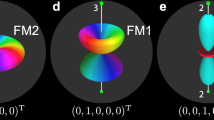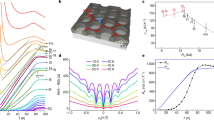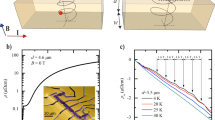Abstract
Phase-slips control dissipation in many bosonic systems, determining the critical velocity of superfluid helium1 and the generation of resistance in thin superconducting wires2. Technological interest has been largely motivated by applications involving nanoscale superconducting circuit elements, such as standards based on quantum phase-slip junctions3. Although phase slips caused by thermal fluctuations at high temperatures are well understood4, controversy remains over the role of phase slips in small-scale superconductors5—in solids, problems such as uncontrolled noise sources and disorder complicate their study and application6. Here we show that phase slips can lead to dissipation in a clean and well-characterized Bose–Hubbard system, by experimentally studying the transport of ultracold atoms trapped in an optical lattice. In contrast to previous work, we explore a low-velocity regime described by the three-dimensional Bose–Hubbard model that is unaffected by instabilities, and we measure the effect of temperature on the dissipation strength. The damping rate of atomic motion (the analogue of electrical resistance in a solid) in the confining parabolic potential is well fitted by a model that includes finite damping at zero temperature. The low-temperature behaviour is consistent with the theory of quantum tunnelling of phase slips, whereas at higher temperatures a crossover consistent with a transition to thermal activation of phase slips is evident. Motion-induced features reminiscent of vortices and vortex rings associated with phase slips are also observed in time-of-flight imaging. These results clarify the role of phase slips in superfluid systems. They may also be of relevance in understanding the source of metallic phases observed in thin films7,8, or serve as a test bed for theories of bosonic dissipation based upon variants of the Bose–Hubbard model9.
This is a preview of subscription content, access via your institution
Access options
Subscribe to this journal
Receive 51 print issues and online access
$199.00 per year
only $3.90 per issue
Buy this article
- Purchase on Springer Link
- Instant access to full article PDF
Prices may be subject to local taxes which are calculated during checkout



 .
. 
Similar content being viewed by others
References
Langer, J. S. & Fisher, M. E. Intrinsic critical velocity of a superfluid. Phys. Rev. Lett. 19, 560–563 (1967)
Langer, J. S. & Ambergaokar, V. Instrinsic resistive transition in narrow superconducting channels. Phys. Rev. 164, 498–510 (1967)
Mooij, J. E. & Nazarov, Y. V. Superconducting nanowires as quantum phase-slip junctions. Nature Phys. 2, 169–172 (2006)
Tinkham, M. Introduction to Superconductivity 2nd edn, Ch. 8 (McGraw Hill, New York, 1996)
Bezryadin, A., Lau, C. N. & Tinkham, M. Quantum suppression of superconductivity in ultrathin nanowires. Nature 404, 971–974 (2000)
Bollinger, A. T., Rogachev, A. & Bezryadin, A. Dichotomy in short superconducting nanowires: Thermal phase slippage vs. Coulomb blockade. Europhys. Lett. 76, 505–511 (2006)
Goldman, A. M. Superconductor-insulator transitions in the two-dimensional limit. Physica E 18, 1–6 (2003)
Phillips, P. & Dalidovich, D. The elusive Bose metal. Science 302, 243–247 (2003)
Fisher, M. P., Weichman, P. B., Grinstein, G. & Fisher, D. S. Boson localization and the superfluid-insulator transition. Phys. Rev. B 40, 546–570 (1989)
Greiner, M. et al. Quantum phase transition from a superfluid to a Mott insulator in a gas of ultracold atoms. Nature 415, 39–44 (2002)
Jaksch, D. et al. Cold bosonic atoms in optical lattices. Phys. Rev. Lett. 81, 3108–3111 (1998)
Cataliotti, F. S. et al. Josephson junction arrays with Bose-Einstein condensates. Science 293, 843–846 (2001)
Henderson, K. et al. Experimental study of the role of atomic interactions on quantum transport. Phys. Rev. Lett. 96, 150401 (2006)
Fertig, C. D. et al. Strongly inhibited transport of a degenerate 1D Bose gas in a lattice. Phys. Rev. Lett. 94, 120403 (2005)
Cristiani, M. et al. Experimental properties of Bose-Einstein condensates in one-dimensional optical lattices: Bloch oscillations, Landau-Zener tunneling, and mean-field effects. Phys. Rev. A 65, 063612 (2002)
Mun, J. et al. Phase diagram for a Bose-Einstein condensate moving in an optical lattice. Phys. Rev. Lett. 99, 150604 (2007)
DeSarlo, L. et al. Unstable regimes for a Bose-Einstein condensate in an optical lattice. Phys. Rev. A 72, 013603 (2005)
Fallani, L. et al. Observation of dynamical instability for a Bose-Einstein condensate in a moving 1D optical lattice. Phys. Rev. Lett. 93, 140406 (2004)
Cristiani, M. et al. Instabilities of a Bose-Einstein condensate in a periodic potential: an experimental investigation. Opt. Express 12, 4–10 (2004)
Wu, B. & Niu, Q. Superfluidity of Bose–Einstein condensate in an optical lattice: Landau–Zener tunnelling and dynamical instability. N. J. Phys. 5, 104.1–104.24 (2003)
Polkovnikov, A. et al. Decay of a superfluid currents in a moving system of strongly interacting bosons. Phys. Rev. A 71, 063613 (2005)
White, M., Gao, H., Pasienski, M. & DeMarco, B. Bose-Einstein condensates in rf-dressed adiabatic potentials. Phys. Rev. A 74, 023616 (2006)
Vinen, W. F. Mutual friction in a heat current in liquid helium II. III. Theory of the mutual friction. Proc. R. Soc. Lond. A 242, 493–515 (1957)
Stamper-Kurn, D. M. et al. Collisionless and hydrodynamic excitations of a Bose-Einstein condensate. Phys. Rev. Lett. 81, 500–503 (1998)
Haljan, P. C., Coddington, I., Engels, P. & Cornell, E. A. Driving Bose-Einstein-condensate vorticity with a rotating normal cloud. Phys. Rev. Lett. 87, 210403 (2001)
Ferlaino, F. et al. Dynamics of a Bose-Einstein condensate at finite temperature in an atom-optical coherence filter. Phys. Rev. A 66, 011604 (2002)
McCumber, D. E. & Halperin, B. I. Time scale of intrinsic resistive fluctuations in thin superconducting wires. Phys. Rev. B 1, 1054–1070 (1970)
Matthews, M. R. et al. Vortices in a Bose-Einstein condensate. Phys. Rev. Lett. 83, 2498–2501 (1999)
Anderson, B. P. et al. Watching dark solitons decay into vortex rings in a Bose-Einstein condensate. Phys. Rev. Lett. 86, 2926–2929 (2001)
Plourde, B. L. T. et al. Influence of edge barriers on vortex dynamics in thin weak-pinning superconducting strips. Phys. Rev. B 6401, 014503 (2001)
Greiner, M. et al. Exploring phase coherence in a 2D lattice of Bose-Einstein condensates. Phys. Rev. Lett. 87, 160405 (2001)
Blakie, P. B. & Porto, J. V. Adiabatic loading of bosons into optical lattices. Phys. Rev. A. 69, 013603 (2004)
Ho, T.-L. & Zhou, Q. Intrinsic heating and cooling in adiabatic processes for bosons in optical lattices. Phys. Rev. Lett. 99, 120404 (2007)
Rey, A., Pupillo, G. & Porto, J. V. The role of interactions, tunneling, and harmonic confinement on the adiabatic loading of bosons in an optical lattice. Phys. Rev. A. 73, 023608 (2006)
Denschlag, J. H. et al. A Bose-Einstein condensate in an optical lattice. J. Phys. B 35, 3095–3110 (2002)
Acknowledgements
We thank R. Barankov, E. Demler, P. Goldbart, N. Goldenfeld, D. Pekker and P. Phillips for discussions, and D. S. Jin, N. Mason and J. V. Porto for critically reading this manuscript. This work was supported by the National Science Foundation, the Office of Naval Research and the UIUC Research Board. D.M. acknowledges support from the Carver Foundation and NSERC.
Author information
Authors and Affiliations
Corresponding author
Rights and permissions
About this article
Cite this article
McKay, D., White, M., Pasienski, M. et al. Phase-slip-induced dissipation in an atomic Bose–Hubbard system. Nature 453, 76–79 (2008). https://doi.org/10.1038/nature06920
Received:
Accepted:
Issue Date:
DOI: https://doi.org/10.1038/nature06920
This article is cited by
-
Efficient quantum gates and algorithms in an engineered optical lattice
Scientific Reports (2021)
-
Topological transitions in superconductor nanomembranes under a strong transport current
Communications Physics (2020)
-
Bogoliubov Theory for a Superfluid Bose Gas Flowing in a Random Potential: Stability and Critical Velocity
Journal of Low Temperature Physics (2018)
-
Velocity-dependent quantum phase slips in 1D atomic superfluids
Scientific Reports (2016)
-
Superfluidity and Chaos in low dimensional circuits
Scientific Reports (2015)
Comments
By submitting a comment you agree to abide by our Terms and Community Guidelines. If you find something abusive or that does not comply with our terms or guidelines please flag it as inappropriate.



